Final Garden Chores to Do Before Winter
Posted on Thursday, March 13, 2025 · Leave a Comment
Winter is fast upon us. The shortest days of the year are ahead, but gardening is done for most of us. That being said, I still have flowers in bloom outside: my witch-hazel trees are showing gorgeous, twisty-petaled yellow flowers, even after a light snow and several hard frosts. And I still have a few blossoms on one of my ‘Knockout’ roses.
If you planted any trees or shrubs this year, make sure they go into the winter well-watered. We’ve had dry times this summer and fall, so a slow, deep watering is needed now. A woody plant’s roots are still growing now – even after leaf drop, and until the ground freezes around them.
I’m not sure why, but I saw very few Asian jumping worms this summer – perhaps the hot, dry weather inhibited their spread. I think I only have them on one portion of my property, but I am being careful about the possibility of spreading egg cases. I like to chop up my fall leaves and save them for use in the garden, but I don’t do that with leaves in the area where I’ve seen those dreaded worms. Instead I just use them for mulching beds already infected with the invasive worms.
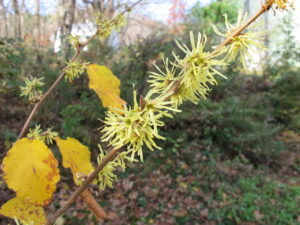
Witch hazel is blooming now, in November
This is the time of year to think about protecting our woody plants from deer predation. I can’t afford to encircle our 2.5 acres of gardens with an 8-foot tall fence, the best way to protect plants. And Rowan, our 4-year old Golden/Irish Setter mix helps discourage deer but he lives indoors and sleeps by the fire all night – just when hungry deer are marauding. Winter is when they want to munch your rhododendrons and other yummy things.
There are several ways to discourage deer. I have found that garlic clips attached to branches about 3 feet off the ground are good. I buy some called “Fend Off Deer and Rabbit Odor Clips”. These are little green plastic cylinders that contain garlic oil. They repel deer for up to 5 months. Unlike sprays that wash off after a hard rain, these really do a great job. I’ve seen footprints of deer that approached tasty shrubs, sniffed and walked away.
If you have had deer eat the lower branches of you yews, a favorite evergreen for deer, you can also protect your plants by wrapping them with burlap. Yes, tedious, but it is 100% effective. I have done it for years for a client.
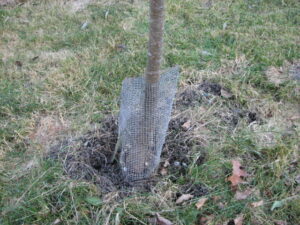
Hardware cloth to protect apple tree from voles 003
Voles, chubby rodents with short tails, are common everywhere and love to nibble on the bark of young trees, particularly fruit trees. You can protect your trees by placing a cylinder of quarter inch “hardware cloth” around them. It comes in 18-inch rolls, which you can cut with tin snips. Wear gloves, it’s razor sharp when cut. But don’t let your tree engulf the wire – which it can do in 3 years or so.
I know that March is traditionally the time for pruning fruit trees, but November is fine, too. And you shouldn’t have to wade through deep snow to do so. A quick reminder of how to do this: Start by removing any dead or damaged branches. Next evaluate the overall form of the tree: Is it a handsome plant? Can sunshine get to every branch? Is there clutter that should be removed? If so, get to those branches next. Evaluate the future of any branch in question: what will it be like in 5 years?
Branches on the outside of the tree that are headed back to the center of the tree should be removed. And of course, remove those pencil-thick upward racing water sprouts before they become big. Rubbing or crossing branches? “Off with their heads”, as the Red Queen would say in Alice in Wonderland.
It is not too late to plant spring bulbs. Selection in stores and on-line may be limited, but there is no such thing as a terrible tulip or disgusting daffodil. Daffodils are, generally, more successful than tulips as they are slightly toxic and not eaten by deer or rodents. But next spring you can surround or cover your tulip beds with chicken wire to keep deer from eating them. I generally plant 100 tulips inn my vegetable garden each year to use as cut flowers and as gifts or friends and the elderly. I treat them as annuals, pulling the bulbs to make room for tomatoes or lettuce in summer.

A simple plywood A frame will protect a shrub from snow and ice coming off the roof
If the previous owners of your house planted shrubs around the house, snow from roof may slide off and break branches, particularly if you now have a steel roof. You can save them by making little plywood A-frames. Do this by screwing legs made of strapping or hardwood stakes onto lightweight plywood. Drill holes at the tops of the legs allowing you to connect front and back with a piece of wire so you can spread the A-frame out as needed, and fold it up to put away in spring.
Be sure to drain your hoses and put them away before winter.
Thanksgiving is coming. I celebrate the harvest, as well as my good health, good friends and family, and living in a safe part of the world. I make a point of celebrating by serving vegetables that I have grown myself. This year I have, from my garden, potatoes, carrots, Brussels sprouts, Swiss chard, kale, Italian dandelion greens and garlic. And we’ll make extra applesauce to give to our guests.
So do a little more work in the garden now. It will help dispel the winter doldrums.
Henry lives and
gardens in Cornish Flat, NH. E-mail him at
henry.homeyer@comcast.net or write him at PO Box 364, Cornish Flat, NH 03746.
Early Harbingers of Spring
Posted on Monday, February 28, 2022 · Leave a Comment
Here in Cornish Flat, New Hampshire, we recently had our first day that shouted “SPRING IS HERE!” After a night of cool rain, the sun came out and temperatures climbed into the 50’s. Now all we need are spring flowers. Me? I solved that problem by potting up bulbs last November and storing them in my cool basement. They rested, grew roots, and now my windowsills are crammed with pots of daffodils and crocus, some blooming, others on the way. They will help to keep my spirits up when we get, as I know we will, day after day of gray drizzle before summer gets here.
Of the outdoor bulbs, the first to bloom are snowdrops. They push up through frozen earth on south-facing hillsides starting in late February. I imagine they can do this by the process of “thermogenesis”. That’s a process whereby a plant can produce a chemical reaction that produces heat. Few can do it, but those that do can get pollinated before anything else.
The poster child for thermogenesis is skunk cabbage. This is a plant I remember well from my boyhood home in Woodbridge, CT. We had a small brook behind the house, and some wet areas along the banks in a woody area. Aside from being the first green plant to sprout, skunk cabbage had the ability to produce a noxious odor that was endlessly fascinating to young boys. I discovered that if I disturbed them, they produced a skunky odor that my sister did not like.
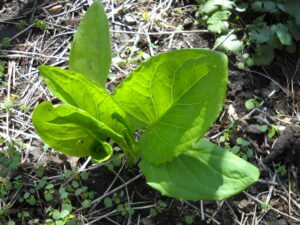
Skunk cabbage has big leaves and grows in moist shade
Skunk cabbage (Symplocarpus foetidus) is related to the common Jack-in-the-pulpit we all know and love. Like Jack, its flower is hidden inside a spathe, or outer leafy jacket. I bought a skunk cabbage plant at Garden in the Woods, a native plant sanctuary in Framingham, MA about 25 years ago.
What I did not know was that skunk cabbage is very slow growing, and does not spread at all quickly, at least this far north. Only in recent years has it bloomed, though every year the leaves have gotten bigger. Now I know when buying plants to buy at least three in order to make a statement in a reasonable amount of time. Skunk cabbage produces big green leaves and a barely noticeable flower.
Of the native woody plants, spring witch hazel (Hamamelis vernalis) is the earliest that I know. In southern New England it can bloom in January, and here in New Hampshire it can bloom in March. I bought one last summer, and look forward to seeing the blossoms soon. I have several fall witch hazel that bloom in October and November. The blossoms vary from yellow to brownish red and are spidery in form. Small, but plentiful right near the stems.
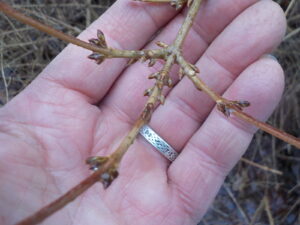
Forsythia flower buds are pointy
Forsythia is a nice yellow-blossomed shrub originally from Asia and eastern Europe. Michael Dirr, my woody plant guru, describes it this way: “Rank-growing, deciduous shrub, differentially developing upright and arching canes which give it the appearance that the roots were stuck in an electric socket; always needs grooming, one of the most over-rated and over-used shrubs; will sucker (slowly) to form large colonies.” That from his “Manual of Woody Landscape Plants”, my favorite text on trees and shrubs.
His remarks notwithstanding, I grew up with it and like it. It is a burst of yellow at a time of the year –April, here – when not much else has bloomed or even leafed out. My gardening Grampy had a large patch of it that had suckered and created a bed 10 feet wide, 50 feet long and 8 feet high or more. My sister Ruth Anne and I would crawl inside the patch of forsythia in the heat of summer for a cool respite – and to hide from grownups.
The trick to managing forsythia is to prune it hard and often. Keep the tips of branches off the ground as they will root in if touching the soil. One can keep it as a nice vase-shaped shrub, and it really does not take much work to do so. Cold hardy varieties that will bloom in Zone 4 include New Hampshire Gold, Vermont Sun and Meadowlark, among others. Ask at your local independent nursery.
Forsythia forces easily. Cut some stems with flower buds now and place them in a vase, and place it in a sunny window. I shall cut some today and get them blooming in a couple of weeks or less. The key is to recognize the flower buds: they are pointy and often appear on cluster without stalks, right on the stems. Straight young stems that grew last year rarely have flower buds.
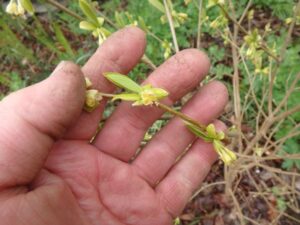
Leatherwood blossom close up
In contrast to the flamboyant forsythia is a nice native, leatherwood (Dirca palustris). This understated plant blooms just as it leafs out in March, April or early May, depending on where you are. It does best in full shade. Although Dirr’s book says it prefers a moist, dark soil, I have it in a dry location and it does just fine. The blossoms are pale to bright yellow, small, but plentiful. The bark is a handsome gray. But it is hard to find in a plant nursery. I bought one several years ago and have looked for others, but have not found another nicely shaped specimen. Look for it. Slow growing, it requires little or no care.
T.S. Elliot wrote in his poem The Wasteland that “April is the cruelest month”. I disagree, I think March is. Muddy roads and gray skies predominate. Flowers are scarce. We have April to look forward to, but if you pot up some daffodils next November for forcing, you can at least have some indoor blossoms now, in March.
Henry Homeyer writes and gardens in Cornish Flat, NH.
Fifteen Flowers That Bloomed in October in My Garden
Posted on Tuesday, October 29, 2019 · Leave a Comment

Witch hazel November
Despite frost and short days, my garden produced plenty of flowers in October. I look for plants that will perform in the shoulder seasons – March, April, October and even November. Here are some I love that are blooming still, or that bloomed earlier in October.
- My ‘Knockout’ roses were still blooming in late October. This trademarked variety has me completely loyal to them. They start blooming in June, and continue until Halloween or later. Not every bush blooms every day, but some do. Most are not fragrant, though that has its advantage: they don’t attract Japanese beetles or rose chafers.
- Seven Sons Flower tree (Heptacodium micinoides). The small white flowers on this tree are delicate, and slightly fragrant. It’s fast growing, small tree that needs annual pruning – it can grow stems up to 7 feet long in one season, though it shouldn’t get taller than 25 feet or so. Hard frost damages the flowers.
- Witchhazel (Hamamelis virginiana). This understory tree has small curly yellow blossoms that really aren’t obvious until late October when the yellow foliage falls off. The branches of mine are loaded with blossoms now, and will look good well into November. Not a showy plant, but a welcome treat at this time of year.
- Disanthus (Disanthus cercidifolius). This large shrub has spectacular purple foliage, more dramatic than the reds of burning bush (Euonymus alatus). And if you get up close for a look, it has little half-inch red blossoms in October. Quite a worthy shrub, but not well known. Even though I’m in a cold zone 4, and this shrub is said to be only hard to Zone 5 (minus 20), I’ve had it for several years.
- Autumn crocus (Colchicum speciosum). This is my one

Colchicum
bulb plant for October. It is similar to spring crocus, but many times larger. I was given a dozen bulbs 20 years ago, and now I have just one left – the others seem to have disappeared. It displays its foliage in spring which then disappears. In October large pink (or white or lavender) blossoms appear. Floppy, but wonderful. I shall buy some more next summer.
- Fall monkshood (Aconitum carmichaelii ‘Arendsii’). You may know the June-blooming monkshood (Aconitum napellus), but this late bloomer is a treat that blooms in late October. It grows to be 4 to 5 feet tall, and has an intense blue-purple hooded flower. Also called wolf’s bane because the sap was used allegedly used to poison wolves in Russia by spreading it on meat that was left out for wolves.
- Blooming with my monkshood is a pink-magenta phlox. Unlike the other phlox I have, this one starts late and just keeps on blooming. I wish I knew the cultivar name, as it has little mold or mildew, too. A good cut flower.
- Rudbeckia I have 2 varieties that bloom well into October. ‘Henry Eiler’ is just finishing up. A 5-foot tall plant with petals with gaps between them give it a distinctive look. And then there is ‘Prairie Sun’ which blooms from late June until now. It has a green eye, instead of a brown one.
- Globe flower (Trollius europaeus). The bright yellow flowers are a complete surprise, as it should bloom in early summer. But this year it is in full, glorious bloom in the last week of October. Go figure.
- New York ironweed (Vernonia noveboracnesis). This is a tall purple flower that looks a lot like a New England aster. It can reach 5 to 6 feet tall in moist rich soil, which it likes best. I now grow it in dry soil, as it got too big in moist soil. It bloomed well though mid-October for me.
- New England Aster (Aster novae-angliae). Another tall fall bloomer, I have pink and purple varieties that often reach 5 to 6 feet tall. Monarch butterflies love to get some nectar from the flowers before heading south.
- Canadian burnet (Sanguisorba canadensis). A native plant of the wetlands, this tall flower appears as a dozen thin bottle-brush flowers on each stem, in clusters. I have 3 or 4 other species in this genus that bloom earlier in summer.
- Sneezeweed (Helenium autumnale). This flower was named after Helen of Troy, a woman so beautiful that it said she launched 1,000 ships. I have it in various colors: yellow, yellow and rust, orange and brown. It can be 5 feet tall, or as short as 2 feet, depending on where it is grown and the cultivar. It does fine in ordinary garden soil, but thrives best in moist soils. Sneezeweed does not make you sneeze – it was used as snuff in earlier times.
- Pink Turtlehead (Chelone lyonii). This tall pink flower blooms for 6 to 8 weeks with multiple hooded pink flowers on tall stems. Bumblebees love this flower, though it is a challenge for them to crawl inside for pollen. It finished blooming in mid-to-late-October.
- Fountain grass (Miscanthus sinensis ‘Morning Light’).
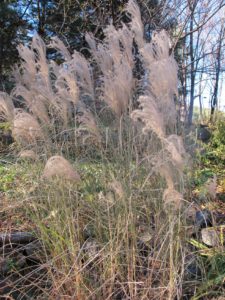
Miscanthus sinensis ‘Morning Light’ looks good much of the winter
Most of us do not think of grasses as having flowers, but they do, of course. This 6- to 8-foot tall grass has wonderful fluffy panicles a foot long or so. They move well in the breeze, and many stay erect through much of the winter.
So if you think that flowers finish blooming in September with the last of your daylilies, think again! Buy some of the plants I mentioned next spring and plant them. October flowers can be spectacular.
Henry is available to speak to your garden club or library. Reach him at
henry.homeyere@comcast.net or P.O. Box 364, Cornish Flat, NH 03746.
Winter Color on the Table
Posted on Monday, November 21, 2016 · Leave a Comment
I garden for many reasons. I want to grow my own chemical-free food, to have an excuse to be outside a few hours every day, and to have flowers on my table most of the year. Right now I have just 2 out of 3. A good batting average for a ball player – better than David Ortiz, for example – but not good enough for me. I want to hit one thousand. I need color and beauty in my house all year.

Winterberry
I almost always have a pair of pruners in my car, so when driving past an uninhabited swampy area recently I stopped to pick some winterberries. These red berries are the fruits of our native holly, Ilex verticillata. Unlike the evergreen varieties with shiny green leaves, winterberry drops its leaves in the fall, but clings to the red berries displayed on the female bushes.
Winterberry is dioecious, meaning that there are male and female bushes, and (remember that lecture you got ever so long ago about the birds and bees?) only the females produce fruit. And only if there are males present. If you buy winterberry plants, a good nursery will be sure to sell you a male to go along with your females. One male for 5 females is adequate.
Winterberry is a very satisfactory garden plant. It prefers moist soil and will grow in standing water – though I have seen it succeed in ordinary garden locations, though not in dry, sandy places. It does best in acidic soil, with a pH of 4.5 to 6.5, so add some sulfur to the planting hole. It produces the most berries in full sun. Soil rich in organic matter is a plus.
It is very cold hardy, surviving temperatures to minus 40 degrees (Zone 3). It is a moderate-sized shrub, rarely getting much more than 6 to 8 feet tall and 4 feet wide. I’m not sure why I haven’t planted much of it, as it brightens the winter landscape with its bright berries standing in contrast to the snow. Next year I will plant some more. Remind me!
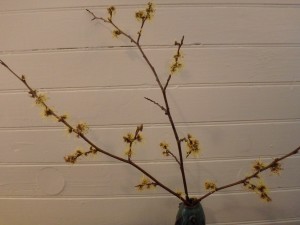
Witchhazel
Of my outdoor flowering plants, only witchhazel (Hamamelis virginiana) is still in bloom. Its yellow flowers have strap-like curly petals that remind me ever so slightly of yellow spiders dancing on the branches. The flowers are, theoretically, fragrant, but I have never noticed such.
Witchhazel will bloom in sun or shade and prefers moist soil. It has an open, branching habit. It is native to our area, and I first met it in the fall, hiking through a woods; I was intrigued to find something blooming after leaf drop, and looked it up. I have two that I planted, and after 10 years they are about 10 feet tall – but somewhat wispy. They are considered small trees or large shrubs and will grow up to 20 feet tall, but can be kept smaller with pruning.
My fallback position for color on the table is to visit my local florist on a regular basis for cut flowers. For 10 to 15 dollars I can get a nice arrangement of flowers that will last up to two weeks. Ask for flowers that will last a long time in an arrangement. Chrysanthemums are great, as are alstroemeria and carnations; lisianthus, spray roses, statice and monkey paws last well, too.
Each fall I also purchase an orchid. Orchids are thought by some as fussy or temperamental, but if you treat them right, they will bloom for months – and even come back and bloom the following year (though that is tougher). The most common orchids sold are Phalaenopsis orchids. Twenty years ago they were dreadfully expensive, but growers in Holland and Taiwan now produce them by cloning – producing hundreds of thousands of them for sale in big box stores.
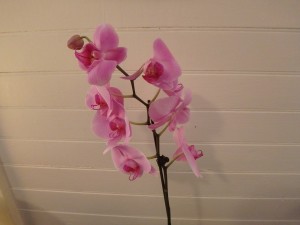
Phaelanopsis
Phalaenopsis orchids like bright light, but no direct sunshine. They do not do well with cold temperatures, but home temperatures are generally fine – even though they come from greenhouses with temperatures in the 80’s. Don’t place them near radiators, woodstoves or doors to the outside. And never let the roots sit in water!
When buying an orchid try to find one that not only has pleasing colors, but also has plenty of buds. The stems will blossom from bottom to top, but usually you will only get blossoms from existing buds. I have cut back flower stems part way to the base after blooming, and gotten side shoots that blossomed, but that is rare.
Because you can buy a Phalaenopsis orchid for $10 to $15, some people just toss them out after blooming. Not me. I keep them, watering once a week until summer, when I bring them outdoors onto my shady deck. They come in pots with no drainage holes and would drown and die if I left them in those pots, but I lift out the inner pot which is just a stiff plastic mesh, which allows rain to moisten the roots but not rot them.
This year I have 2 Phalaenopsis orchids that I bought last year, and one has started a flower stem. It hasn’t yet started forming buds and I know I will never get it to bloom as magnificently as it did when I bought it. Still, it will add some color in a couple of months – and it cost me nothing this year.
Most Americans waste money on unnecessary items from time to time. Me? I’d rather waste a little money on house plants and cut flowers than most other things.
Read Henry’s blog at https://dailyuv.com/gardeningguy. He is the author of 4 gardening books.
Picking for Vases
Posted on Wednesday, November 4, 2015 · Leave a Comment
This is a hard time for those of us who love to go to the garden to pick flowers to grace the table. We’ve had a few weeks of cold weather, and even the hardiest of flowers seem to have faded away. So what can a gardener do?
Think outside the box. We can pick stems of shrubs with colorful or interesting bark. We can snip off branches of evergreen trees. And there are decorative grasses and even some dry weeds that have interesting form.
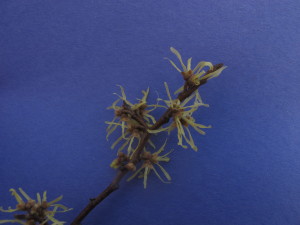
Witchhazel blossoms
Actually, I do have one thing still blooming: my witchhazel (Hamamelis virginiana) shrubs are in their glory now that their leaves have dropped. They are remarkable yellow blossoms that consist of curly yellow straps. Their fall foliage is yellow and the blossoms appear while the leaves are still on the branches – and are easily missed. Now the leaves are gone and the blossoms are prominent.
Witchhazel comes in several species. There is a spring blooming variety, H. vernalis, that blooms as early as March. Some varieties of this species also have spectacular fall leaf color. The variety ‘Autumn Embers’, a spring bloomer, has great fall color. I have yet to try this species, but it’s on my wish list.
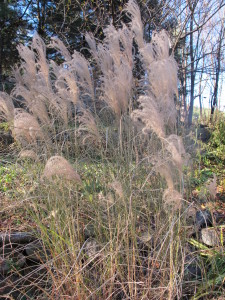
Miscanthus sinensis
Most grasses and branches lend themselves to making big arrangements. I decided to try working with some to make something shorter as tall arrangements on the dining room table block my vision of a diner across from me. I cut stems of fountain grass (Miscanthus sinensis) which is well over 6 feet tall in my garden, but I just used the top 18 to 24 inches of each stem. They are in blossom right now, meaning that they display fluffy plumes above the foliage.
I also cut the bare red stems of red-twigged dogwood, which is also known as red osier dogwood (Cornus sericea). This is a plant that I cut to the ground each spring. New growth has bright red bark that seems to get brighter in the winter. In the wild it lives in wet places, and I grow it in moist soils, but it will grow in ordinary garden soil. I cut it back to keep the size in check, but mostly to get bright red color. Other varieties of the species produce yellow stems.
So I had bright red in the vase, and tawny beige grasses. I needed some greenery. I have lots of Canadian hemlock, but have found that the needles do not hold on well. White pine would work, but I wanted a different look. I cut a few stems of a hellebore, a perennial flower with evergreen leaves. The stems rise up a foot or so, then send out horizontal clusters of shiny green leaves, which seemed perfect. The leaves did well for a couple of days, then got droopy.
Other plants that often have good looking leaves at this time of year include European wild ginger (Asarum europaeum), dead nettle (Lamium spp.), myrtle or periwinkle (Vinca minor) and pachysandra (Pachysandra spp.). And although a vase full of just leaves may not be interesting in summer, a little greenery in a low bowl with a few stones is not bad now.
Of the leaves mentioned above, pachysandra is the best: it will last all winter in a vase, rooting and looking perky. Pick some now for use all winter.
In my vegetable garden I still have a number of plants that might also look good in a vase. Kale comes in a variety of colors and leaf types. All do well in a vase, and purple kale can be very striking. Mint also holds up for several days in a vase – and you can nibble on the leaves.
If you grew last winter’s amaryllis outdoors in a pot all summer, (hoping it might re-bloom for you this year), now is the time to give some tough love. You need to stop watering it, and let the leaves yellow and die. Cut off the leaves and keep it in a cool dark place for six weeks. It needs that dormant time if it is to re-bloom.
I usually take my amaryllis out of its pot, shake off any soil, and put it in a brown paper bag. Then I store it in my basement, which is between 45 and 55 degrees at this time of year, which is perfect. After 6 weeks I re-pot it and bring it up into the warmth of the house, but keep it out of direct sunshine for a while. Date the bag so you will know when to bring it into the light.
If you want to be sure of having a blooming amaryllis for the holiday season, go buy one now. They generally come with all you need: pot, potting soil, instructions. Don’t overwater it as the bulbs can rot. And this advice: bigger, more expensive bulbs are worth the money. The cheap ones you can get in a Big Box store will bloom, but you will probably just get one bloom stem, not two, and the blossoms will generally not be nearly as dramatic, nor be as numerous. I’ve learned the hard way.
Winter is breathing down our necks. I’m using the woodstove almost every day. And although I get a few things from my garden to put in a vase, I like to visit my local florist and buy some real flowers, too. If you’re on a limited budget, ask your florist for flowers that will last well in a vase. We gardeners all need flowers- even winter!
Henry is a garden consultant, coach, and a UNH Master Gardener. His web site is www.Gardening-guy.com.
What’s Blooming Now in the Garden
Posted on Wednesday, October 23, 2013 · Leave a Comment
By mid to late October, many gardens are looking quite drab. That need not be the case, and this week I’d like to mention a few of the flowering plants that are cheering up my gardens now.
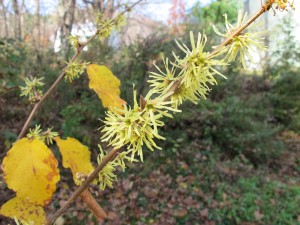
Witch Hazel blossoms
Witch hazel (Hamamelis virginiana) is a native shrub that grows in the understory and blooms now (or in the early spring, for Hamamelis x intermedia). The flowers are not dramatic on most varieties– they are less than in inch in diameter, and are arranged close to the stem. Although I’ve seen witch hazel in a public garden that had red blossoms, the native species that I grow is a pure yellow and the petals are very frilly – you could say “spider-like”. The look best after leaf drop.
As a kid I went to a barber who used a witch hazel tonic as an astringent after shaving men. To make us kids feel more grown up, perhaps, he applied some on the back of our necks when he was done with us. It is a very fresh scent that is made from the bark of young stems and roots of the shrub. The leaves, when crushed, also have a nice smell.
My Seven-Sons Flower Tree (Heptacodium miconioides) is still blooming now. This is a smallish tree (under 30 feet tall), but one that grows extraordinarily fast. It is not unusual for new stems to grow 3 to 5 feet in a season. I love the bark, which is exfoliating (shaggy). Its flowers are small and white, and appear in panicles (clustsers).
I am experimenting with mine to see how it does as a pollarded tree. Pollarding is a process of cutting off most new branches back to major branches every few years, keeping the size in check and crating large knobs where new growth originates. It’s a very popular pruning technique in Europe. Last year I cut off all the smaller branches, leaving a trunk and three major branches. This year I got dense clusters of branches growing from the ends of those major branches. Interestingly enough, many of the new stems are growing out and down, almost like a weeping tree.
Chrysanthemums great fall flowers that I buy in pots each year around Labor Day. I treat mums as annuals, even though some varieties will overwinter. Why? Because to get a dense, compact plant, one must pinch back the growing stems two or more times during the summer, and I have too much going on to remember to do so most years. There are people who do this for a living, and I am happy to let them do it. I like mums in window boxes (the smaller ones) and the big, dramatic ones in pots on my front steps. When they come in peat or cardboard pots I transplant them into plastic pots as the former dry out too quickly.
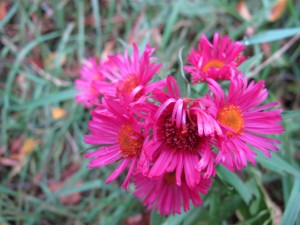
Aster ‘Alma Plotschke’
Fall asters have been splendid this year, both those that I planted and those growing along the roadside or edges of fields. The wild ones are mostly blues and purples. I purchased a pink aster that is in bloom right now, a variety called ‘Alma Plotschke’. She is an intense, deep rose pink and not nearly as tall as the wild ones.
Some smaller wild asters(12 to 24 inches tall are blooming at the edge of my lawn. My reference text on native flowers (The Illustrated Book of Wildflowers and Shrubs by William Carey Grimm) lists 29 species of wild asters. These short ones have bluish-white blossoms. I believe mine are the common blue wood aster (Aster cordifolius), which is usually a light blue or lavender. The differences between wild asters can be minute and there is much variety within a species, so they could be the white wood aster (Aster divaricatus), which is also common in New England. It doesn’t matter, they’re all lovely.
Fall crocus are wonderful! True fall crocus (Crocus sativus) are not fully hardy in my cold Zone 4 garden. Various vendors list them as hardy to Zone 4 or 5 or 6. I have had them winter over, and have a client nearby who has had them blooming each fall for years – in a Zone 4 garden. These crocus are the source of saffron, but I’ve read that it takes 10,000 flowers to make an ounce of saffron!
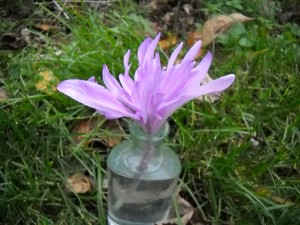
Colchicum in a small vase
Colchicums are also called fall crocus, but are not true crocus. They look like crocus on steroids – they are commonly 6 inches tall! I planted a lot 10 years ago, but each year I have a few less. Unfortunately their stems do not usually support the flowers, so they flop. To avoid this I have planted them in amongst a ground cover like myrtle (Vinca minor) that helps to hold them up. Mine are mainly pink, but also have a few white, both as singles and doubles.
Some annual flowers hold up against frost for awhile, too. My favorite right now is Brazilian verbena (Verbena bonariensis), which is hardy down into the 20’. It grows three feet tall on thin, stiff stems with little clusters of purple-blue flowers. The flowers seem to float above shorter things. Look for it next summer.
Fall flowers are a gift. Even when I’m thinking about woodpiles and snow shovels, a few hardy plants keep on bringing me joy.
Henry is the author of 4 gardening books and a children’s book about a boy and a cougar. His Web sites are www.Gardening-guy.com and www.henryhomeyer.com.



















